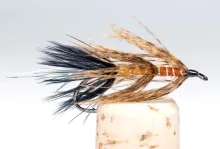The Grey Frede is a surefire pattern for sea trout. It's a very versatile and robust fly that has become very popular. I decided to tie a darker version of the same fly.

The Grey Frede is a surefire pattern for sea trout. It's a very versatile and robust fly that has become very popular. I decided to tie a darker version of the same fly.
The problem with this fly was primarily to find some good feathers for the tail and body. the Frede uses grizzly marabou wich can be bought in large bags, but I hadn't seen black feathers of the same type. Also Peter Loevendahl - father of the Grey Frede - uses dry fly grizzly hackles for the body hackle of his flies, and I had no black dry fly saddles or necks.
The solution was a Hoffmann Chickabou skin. These skins are available in all kinds of colors and they are sold both as grizzly - perfect for Grey Frede's - and black - perfect for my dark frede.
Version with bead chain eyes
| Hook | Partridge Nymph/Emerger, niflor, or large streamer 2-4 |
| Thread | Black |
| Tail | A few straws of black flash black chickabou tailfeather. 1/2 hook length |
| Body | Thick layer of black marabou dubbing - very thick |
| Rib | Copper wire, fairly thick |
| Hackle | Black chickabou bodyhackle |
| Eyes | bead chain eyes under the hook shank (the original has the eyes over the hook shank) |
| Head | Marabou dubbing over the eyes and a small head from tying thread |
Tying Instructions
The tying instructions are almost identical with those of the Grey Frede.
- If using a nymph/emerger hook then put the hook in the vice and straighten it a bit. The hook gap has to be enlarged a bit. The finished hook looks much like a slightly curved Limerick hook.
- Tie in flash on top of the hook bend
- Find two dense marabou tailfeathers and tie in one on each side of the hook to make a flat tail. Leave the surplus as a base for the body
- Tie in a length of copper thread at the hook bend
- Cut of the barbs from a handfull of marabou feathers and mix them well
- Wax the tying thread and dub it with marabou in a thick layer
- Turn the dubbing over the hook to form a compact but fluffy body
- Let the dubbing stop approx. 1/3 from the eye
- Tie in a chickabou body feather as a hackle hackle in front of body. Tie in base first.
- Wind the hackle to the rear end of the body
- Lock down the hackle with the copper thread. Wind it opposite the hackle over the body
- Tie down copper thread and cut surplus
- Tie a couple of bead chain eyes on under the hook shank in front of body
- Dub the thread again and form a large head over and in front of the eyes
- Form a small head from thread, whip finish and varnish
- Stroke the whole fly lightly with a brush.
Alternative version with a bead
| Hook | Kamasan B840 size 2 |
| Head | Medium brass bead |
| Thread | Black |
| Tail | Black marabou feathers and a few flash straws |
| Rib | Copper wire |
| Body | Black marabou dubbing |
| Hackle | Large, black hen hackle |
Tying Instructions
- Slip the bead over the hook bend and secure behind hook eye with glue or varnish
- Start the thread behind the bead
- Cover the hook shank with thread
- Tie in flash over the hook bend
- Tie in two marabou feathers - one on each side of the hook shank
- Leave the base of the feathers and tie them down over the hook shank to right behind the bead
- Fold the feathers back and tie down to form a base for the body
- Cover the feathers with tying thread finishing over the hook bend
- Cut surplus
- Tie in copper wire under hook shank
- Dub the thread heavily with marabou dubbing. Use wax if necessary
- Form a thick, fluffy body
- Prepare a large, soft hen hackle
- Tie in base first, shiny side facing forwards in front of body, just behind bead
- Wind the hackle 4-6 times backwards to form a palmer hackle
- Wind ribbing 4-6 times forwards over hackle to secure it
- Tie down copper and cut surplus
- Whip finish just behind bead
- Varnish
Hand picked for this article
- Log in to post comments









